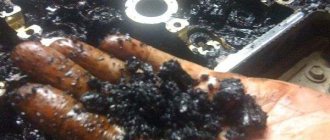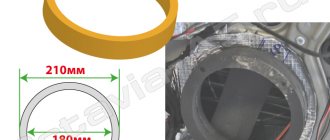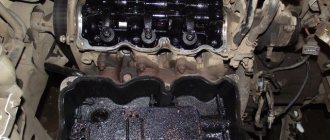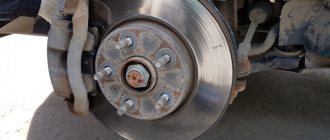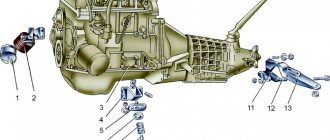Hi all! Such a task as engine decarbonization is faced by many car owners. Some people do it quite simply by sending their car for service. The procedure is not cheap, and you can do it yourself. There would be desire and free time.
Elements inside a diesel or gasoline engine are exposed to an aggressive environment. Gradually, coke, that is, carbon deposits, accumulates on their surface. Hence the concept of a coked engine. And since it is coked, it needs to be decoked. Oh, so many difficult words.
It's actually simple. Coke is a product of fuel combustion. When the engine is filled with these deposits, it begins to perform poorly. If flushing or cleaning is not carried out on time, this may result in major repairs or costly replacement of some elements.
I wouldn't say that the task is difficult. If you act wisely and have the correct instructions at hand, you can do it easily. I believe in you!
How and why does the so-called “coke” deposition occur?
Important: The main “supplier” of the problem is engine oil.
Let's immediately dispel some misconceptions. For some reason, it is generally accepted that slag deposits are possible only on old cars, and they are inherited.
Indeed, modern diesel fuel is cleaner (we reject unscrupulous gas stations, since this is not a systemic problem).
And synthetic oil does not contain a hydrocarbon base, which tends to separate from the composition and stick to the walls of mechanisms. However, the problem of hard deposits is equally inherent in modern power plants.
Causes of coke formation
- technology has become more precise: there are microscopic gaps between the parts of modern mechanisms that are easily clogged;
- engine operation (even diesel) is associated with high temperatures: an ideal environment for precipitation to stick;
Oil deposits on the shaft journals and housing
- the intensity of work has increased: the lubricant is susceptible to separation, individual fractions easily become slag.
In diesel engines, the situation is aggravated by the presence of soot. This is a unique substance: it can be as small as desired, but the dry component does not dissolve in liquid.
When the piston system operates, soot particles enter the ring gaps and are retained in the cavities. Then heated oil gets there, which evaporates on the hot surface of the piston (we note right away that this is possible if the oil scraper rings lose their tightness).
A mixture of hot grease with solid soot particles is the strongest cement. It instantly deposits on the metal and forms a layer of real varnish.
Carbon deposits on the piston and rings
Of course, in this state the rings do not work. Compression and traction disappear, fuel consumption increases. And the saddest thing is that the problem of coking is growing exponentially. Loaded oil scraper rings allow more and more oil into the hot zone, and the slag layer increases.
The same picture is observed in the timing system. Valves (especially exhaust valves) also operate under intense temperature conditions. If there is motor oil in the cylinders (and we know that it gets there when the rings become coked), then again, together with the soot of the exhaust gases, a dense mass is formed, which over time turns into stone.
Coked engine valves
Another problem that requires diesel decarbonization is incomplete combustion of fuel. During operation, light fractions evaporate and burn, and heavy sediment concentrates in the cavities. Mixing with soot and oil, these compounds again form a layer of slag, which becomes more and more monolithic over time.
Consequences of soot
- Violation of the tightness of the piston rings, valve mechanism;
- The so-called “bedding” of moving elements;
- Reducing the volume of the combustion chamber: hence the loss of power;
- Carbon deposits on the upper arch of the cylinder can lead to untimely ignition of the fuel;
- The biggest problem is the malfunction of the lubrication system.
We recommend: Replacing the alternator belt tensioner pulley - you need to know this
More about this:
The flow area of the oil channels is reduced: the consequences require no comment. Vibrations may cause small pieces of slag to fall off the walls. These elements can clog the same oil lines and damage various sensors.
Removing carbon deposits with water
Some motorists have learned to use a milder procedure that has the same effect in removing carbon deposits as chemicals. Decarbonization with water is the most common method that owners of domestic and imported cars decide to use.
For the procedure you will need:
- distilled water in a plastic bottle;
- dropper;
- hose (for windshield washer);
- tee (connect the washer).
The scheme of work is as follows: water from a bottle is connected through a dropper to the engine suction. You can use non-distilled water - the filtration system in the dropper itself will handle the cleaning. Water supply starts with the engine running - at approximately 2000 rpm.
2-3 drops per second is enough when the engine is idling when the engine is warm. The effect will not take long to appear, the carbon deposits are removed, and the car becomes dynamic and economical.
When to decarbonize the engine?
The procedure gives a positive result if performed in a timely manner. You can’t delay it too much - you’ll just waste your money, because chemicals are not cheap. When decarbonization becomes useless:
- When driving for a long time with high oil consumption. If the engine “devours” 1 liter of lubricant per 1000 km or more, and you do not take any measures for 2–4 months, then get ready to make major repairs. The carbon deposits will clog the rings and oil drain holes so much that chemicals will not help, only mechanical cleaning.
- If compression in one or two cylinders has dropped to zero. This indicates burnt valves that the cleaner will not pick up.
- If noise or knocking occurs in the engine, requiring immediate replacement of parts.
You can perform decoking at your own risk, but with the symptoms listed, the chances of success are extremely low. Sometimes the opposite effect is observed - after cleaning, the compression in the engine drops and further driving becomes impossible, the engine loses a lot of power.
The reason for the phenomenon is the same carbon deposits. By covering all accessible surfaces, the coke begins to serve as a seal instead of the piston rings and, together with the lubricant, creates increased pressure in the chamber, sufficient to ignite the fuel mixture (so-called oil compression). After cleaning, the seal deposit disappears, and the pressure in the cylinders drops due to wear of the CPG elements. The motor refuses to work.
Practice shows that a special liquid for engine decarbonization should be used at a consumption of engine lubricant of 0.3–0.5 liters per 1 thousand kilometers. At this moment, intensive carbon deposits begin, but irreversible consequences have not yet occurred. If the culprits of the oil burn are valve seals, then after the procedure they can be changed and driven over 20 thousand km, provided that the CPG is in satisfactory condition.
Where does carbon deposits come from and where does it accumulate?
The cleaning procedure is not a panacea and does not always help, and sometimes gives the exact opposite effect. To use the technique correctly and on time, you need to understand the reason for the formation of deposits and the consequences of this phenomenon.
The cylinder-piston (CPG) and valve group of an internal combustion engine operates under difficult conditions - at high pressure and temperature. Over time, the rubbing surfaces of the parts wear out, and the seals lose their tightness, which is why engine oil begins to penetrate into the combustion chambers. The combustion conditions of the air-fuel mixture worsen as the lubricant burns out and forms a hard deposit on all accessible surfaces:
- piston skirts and chamber walls - first of all;
- side surfaces of the pistons in contact with the cylinder walls;
- the front planes of the valves and their internal surfaces adjacent to the seats;
- grooves for piston rings and holes for draining liquid lubricant (located deep in the groove of the oil scraper ring).
At the same time, the electrodes of the spark plugs become covered with soot, which reduces the quality of spark formation.
When the amount of lubricant penetrating inside the cylinder becomes critical, black coke clogs all possible cracks and holes. Because of this, the rings get stuck in the grooves (in the jargon they lie), causing the actual compression in the cylinders to drop by 50-90%. A valve that is burnt on the seat side will not close hermetically, and then the compression pressure will drop completely to zero - the cylinder will completely fail. The consequences can be prevented if the engine is decarbonized in time.
Engine decarbonization methods
- Partial decarbonization. Experts call this method soft. Before changing the engine oil, a special agent is added to its composition. Then oil is poured into the engine and driven for some distance without loading the engine too much. It is not recommended to drive at high speeds. After 200 km the oil is changed. This is a simple and inexpensive method. In this case, only certain parts of the engine are cleaned, but the combustion chamber is not cleaned. This is more of a preventive measure carried out when changing the oil.
- Complete decarbonization. This method is tough and allows you to clean the engine most efficiently. However, doing such work requires a lot of time. The machine must be installed on a lift or pit in a horizontal position. The engine is warmed up to operating parameters.
There are many different methods of engine decarbonization that are used at service stations. We will consider the most popular and reliable method - complete decarbonization.
- Before decoking, the engine should be warmed up to operating temperature.
- Unscrew the spark plugs.
- Using a jack, raise the drive wheel and set the gear to overdrive. Next, you need to rotate the wheel until the pistons are in the middle position. You can use a screwdriver to determine their position.
- In this case, we will use a tool called “SURM”. It is used by many masters and is considered quite effective. You need to take 25 milligrams of this product into a syringe and inject it into the cylinder through the spark plug mounting hole. This process is done for each cylinder.
- After pouring the product, you must wait 15 minutes for the carbon deposits to dissolve. During this time, you need to turn the wheel a little so that the liquid penetrates the rings. The wheel turns every three minutes. In this case, no extra turns are required.
- Disconnect the middle wire of the distributor and fix its contacts at a distance of several mm from the engine housing. This will prevent the ignition coil from malfunctioning.
- Turn on neutral speed and turn the starter for about 10 seconds. So it is necessary to force the flushing agent out of the cylinders. This is a very important point, since the presence of liquid in the cylinders when starting the engine can lead to water hammer, which in turn will lead to damage to engine parts.
- Install the spark plugs in their places and start the engine. At first, the exhaust gases will emit an unpleasant odor, but this will quickly pass.
We recommend: Replacing silent blocks: go to a car service center or do it yourself?
The engine should idle for about 15 minutes. After this you can start moving. After driving 200 kilometers, you can check the oil consumption by comparing the new readings with the old ones, the difference should be obvious.
Selecting a cleaning product
In car stores and markets you can find a wide variety of chemicals that are declared by manufacturers as effective cleaners of coke from power unit parts. Which of them are used most often and have earned a positive reputation:
The first 2 drugs are liquid in aerosol packaging with a capacity of 220 and 300 ml, respectively, pumped into cylinders through a tube. The remaining two products are poured in using a syringe. As a rule, one package - a can or bottle - is enough to service one four-cylinder engine with a working volume of up to 1.6 liters. For higher power engines with 6–12 cylinders, 2–3 tanks will be needed.
A few words about the best way to clean the engine. The undisputed leader is considered to be Mitsubishi Shumma, tested in practice by many master mechanics. There is only one drawback - the price of the drug is too high (about 30 USD per can). An alternative is GZox aerosol, which shows similar results at half the cost. Liquids BJ-211 and Lavr close the list of the best cleaners present on the automotive chemicals market.
Advice. You should not use old “old-fashioned” methods to decarbonize the engine of a modern car, pouring a mixture of acetone with solvent (kerosene) and other ineffective liquids into the cylinders. They act too slowly and do not dissolve carbon deposits well.
Causes and symptoms
There are no engines that are perfectly clean inside. Except at the factory. But it happens that some carbon deposits form after 200 thousand kilometers, while others calmly drive all 400-500 thousand. An interesting question, you will agree. But the answer is elementary.
It all depends on how much the so-called provoking factors influence the engine. These include:
- low quality fuel;
- using oil that is not suitable for the vehicle;
- ignoring basic rules for operating the machine;
- the use of structural elements in the engine that do not correspond to it (all kinds of tuning, etc.).
And the more such factors, the sooner decarbonization will be required. Is it necessary? Certainly. Is it worth doing it yourself? Here you can choose for yourself. I did it myself, nothing complicated.
A correct assessment of the situation allows you to start cleaning the insides of the engine in a timely manner. To do this, listen to the car. No, you don’t have to stand and listen to her. Just while driving, pay attention to the characteristic signs of coking:
- dynamics drop and power deteriorates;
- fuel consumption increases;
- the engine rattles like an old diesel when starting;
- compression drops;
- there is a lot of unnecessary noise;
- the motor is troublesome;
- Dark smoke comes out of the exhaust and smokes constantly.
Yes, I would call such signs indirect, since there are a number of other reasons that can provoke such phenomena. Water gets into the oil and that's where you get the smoke.
What to do in this situation? You can disassemble the assembly and check the condition of the elements. If you have never done decarbonization, and the car has a lot of mileage, then even a preventative flush will never hurt.
Used engine
An example with a new engine was considered above. When a car already has a significant mileage of 90 - 100 thousand km, not only the oil scraper rings wear out, but also the entire cylinder-piston group, and accordingly the process of coke formation in the engine accelerates.
Do not forget about the gas distribution mechanism, a similar situation.
As a rule, the symptoms of all this are manifested in the appearance of smoke with a special smell from the exhaust pipe and oily spark plugs. Here you can safely say not “God help you”, but “A good mechanic can help you.”
To draw the right conclusions yourself, pay attention to the following important points:
- Oil consumption > 300 g. at 1000 km, while the mileage of a domestic car did not exceed 100,000 km, foreign cars - 200,000;
- Oil reflective caps allow oil to pass through (signs: there is oil on the threads of the spark plugs, and the exhaust pipe smokes when the gas is changed suddenly.
The oil seals are just being replaced. But it’s better not to do it yourself the first time.
Other causes of engine coking:
- Frequent engine overheating (the reasons may be different) - read more here;
- The engine idles very often;
- Constant urban cycle of vehicle operation;
- Using low-quality motor oil or oil that is not suitable for the engine type;
- Long-term parking of a car without operation (penalty area, parking in winter, after an accident, long-term repairs, etc.).
POPULAR WITH READERS: All about 6th generation HBO, advantages and disadvantages
How to decarbonize a diesel engine?
Academically, there are three ways to remove any solid deposits:
Direct impact method
This could be a simple scraping or stripping. Nobody canceled the sandblasting machine. However, these methods have serious drawbacks.
- Engine disassembly required. In fact - a major overhaul.
- The method removes a thin layer of metal, violating the adjusted geometry.
This does not mean that the method is off the agenda. Mechanical processing is used, but it is better to do it in bench conditions, with control of geometric parameters.
Mechanical method with ultrasound
This method is relatively safe for the parts being cleaned. Only the slag deposit crumbles, the geometry is not violated, and the gaps do not become larger. However, installations for generating ultrasound of such power are quite expensive.
It is not practical to keep such a device in a personal garage. The cost can be compared to the decarbonization of diesel engine rings, performed hundreds of times (with payment for services).
In addition, the destroyed plaque has heterogeneous fragments. All this mechanical debris remains inside the case and can cause a lot of trouble.
Chemical, using special liquids
Perhaps the most popular technique. 20-30 years ago engines were decoked in exactly this way.
Let's look at it in more detail: The advantages of working with liquids are that they do not harm metal parts.
We recommend: What you need to know about installing gas equipment on cars in 2019
note
Plastic sensors, gaskets and rubber seals can be completely destroyed.
Another plus: varnish deposits are completely dissolved, they can be removed through the drain hole, or they themselves fly out into the exhaust pipe.
But the main advantage is local application. To introduce a solvent liquid, complete disassembly of the engine, much less its dismantling, is not required. It is enough to gain access to the hole (for example, unscrew the spark plugs), or remove the valve cover.
In some cases, drugs are added to motor oil or fuel. However, it is this technique (dilution of technical fluids) that causes the most controversy.
Cleaning piston rings.
The rubbing surfaces of pistons and cylinders, as well as the grooves for piston rings, are subject to the formation of varnishes on them. Since carbon deposits and varnish can clog the grooves for the piston rings. Due to the fact that the groove is clogged, the piston ring will expand, which will lead to damage to the cylinders (scores and scratches will appear). Therefore, if there is carbon deposits and varnishes on the upper side parts of the pistons, then operating the car in this situation will lead to premature wear of the cylinders, the repair of which will cost much more. Such reasons lead to a major overhaul of the car engine.
During operation, if the piston rings are expanded, the protective layer - hone - will be torn off from the surface of the cylinders, the cylinder liner will undergo rapid wear and the piston rings themselves will wear out.
Clogging the ring gap or groove, causing the ring itself to expand, can also cause the ring to break. Accordingly, if the piston ring breaks, the cylinder and other parts of the cylinder-piston group (CPG) will be subject to enormous wear.
It may also be that the presence of carbon deposits and varnish in the groove for the piston ring can coke the rings (they will become immobile). This phenomenon is called coking or sticking of the internal combustion engine rings.
If the piston ring has become stuck and motionless, then the compression will be less than with a properly functioning ring. And, as we already know, low cylinder compression of an internal combustion engine increases fuel consumption, forms large layers of soot and coke, increases the likelihood of engine failure during startup and creates interruptions in engine operation. Due to the fact that the tightness is broken due to the presence of the piston ring, more oil enters the cylinder, hence the increased consumption of engine oil (eats oil). An excessive amount of oil on the piston and cylinder walls does not burn and makes the carbon deposit larger and larger. Each subsequent operation of such an engine without repair will lead to coking of the entire engine.
The deposits that appear on the valves cause them to jam in the guide bushings, and the valve supply and exhaust openings become smaller.
The process of cleaning piston rings can also be done with or without disassembly. Without disassembling the engine, liquids such as LAVR, XADO are used to clean the piston rings. The procedure for performing the work is the same as discussed above.
Decarbonization instructions
When warming up the power unit before cleaning, it is worth pouring a flushing compound into the crankcase - “five minutes” in order to remove dirt from the oil channels as much as possible. You should also measure the compression on a hot engine in advance, this will help you see the result before and after decarbonization.
Perform further actions in this order:
- Carefully read the instructions on the cleaning product packaging and find out how much liquid needs to be poured into each cylinder of your engine.
- Remove the spark plugs and clean them thoroughly with a metal brush, rinse with gasoline and blow out.
- While turning the drive wheel by hand with 5th gear engaged, set all pistons to the middle position, measuring the depth with a long screwdriver.
- Lowering the tube one by one into the spark plug holes, fill the cylinders with aerosol from a spray can. Decarbonization of the engine “Lavrom” is carried out using a syringe (included with the drug).
- Screw the spark plugs back in without tightening them all the way.
- Leave for 8–15 hours, periodically moving the crankshaft by turning the wheel. The goal is to help fluid penetrate between the piston rings.
After the time specified in the instructions has passed, unscrew the spark plugs again and try to pump out the dissolved dirt from the cylinders with a syringe, and then blow it thoroughly with a compressor. The better you can clean out the remaining coke, the faster the engine will start.
Install the old spark plugs and start the engine without increasing the speed above 1500 rpm. Let it warm up and “spit out” pieces of carbon deposits through the exhaust tract. After 10–15 minutes of engine operation, when the smoke from the exhaust decreases, return the lambda probes to their place and begin replacing the engine lubricant.
Screw in new spark plugs last, after cleaning the power unit and changing the oil. Before installing spark plugs, re-measure the compression and make sure that the measure has a positive effect. If the result is negative, begin preparations for disassembling and overhauling the motor.
Decarbonization of a diesel engine differs in the method of filling the cylinders with a chemical. Since there are no spark plugs, the fluid is poured through the injector holes. The latter will have to be dismantled after first releasing the fuel pressure in the system and turning off the pump.
Interesting facts about decarbonization
Since the times of the USSR, the quality of gasoline has improved, but the problem remains - any driver is faced with the removal of slag and coke on the piston rings. Soviet oil is also far from modern, but not a single car owner can fully claim that it does not form carbon deposits. Persistent deposits that affect the stable operation of the cylinders will lead to a major overhaul.
Main misconceptions:
- The first incorrect conclusion is that modern engines do not need decarbonization. Any engine is operated in harsh conditions, including winter. This is the first and main reason for the formation of carbon deposits. Modern piston systems have provided parts with smaller clearances and grooves, which increases vulnerability.
- Decoking of XADO, LAVR and other similar decoking agents cannot be called the only method of “treating” an engine. Periodic cleaning with oil changes will give good results, but the products are only good for standard engines. Namely, with a volume of no more than 2 liters, a vertical arrangement of the cylinders, and a shallow recess in the piston bottom. Otherwise, it must be filled with the product separately.
- High cost is a reckless statement from an inexperienced driver. Anticoke costs much less than a major overhaul. For example, decoking laurel, the instructions for use of which are simple and clear, are made in Russia, which means the price is several times lower than imported analogues. According to research results, it ranks second in the Russian market, the soaking time of soaked pistons is 8-10 hours.
- Engine decarbonization fluid works the same for all types of engines. There is no need to look for compounds separately for diesel and gasoline engines. The repair and maintenance operation is performed in a standard manner. Avoid working in winter, outdoors or in the rain.
- Decarbonization of oil scraper rings is impossible with a cold engine. A heated engine provokes a steam bath, softening the carbon deposits. Otherwise, the deposits will not soften, and the effect of the procedure will be zero.
- Using anti-coke is not the only cleaning method. Some car models have a complex design, it is impossible to get close to the technological holes of the cylinders; you will need a set of special tools. The volume of liquid added should not exceed the manufacturer's recommendations.
- Additives for decoking oil rings will not clean carbon deposits white. From a technical point of view, this makes no sense. A composition that is too caustic will cause damage to parts.
After cleaning, the car will smoke, but not always heavily. In addition to slag and other carbon deposits, the system will emit anti-coke residues. If you remove the liquid remaining on the cylinders, there will be much less smoke.
You might be interested in this article -
For convenient introduction of the composition into the holes, some manufacturers add a special syringe to the kit.
Of the products that do not require removing candles, the most popular is Edial decarbonization. The advantages are that they work exclusively in the combustion chamber, activation at elevated temperatures, and cleaning in normal mode.
Mixing is simple - just pour the drug into the fuel tank at the gas station before refueling. The priorities are decoking of the diesel engine, including mineral residues (ash), which are formed at a temperature of 850 degrees.
How to protect your engine from carbon deposits
In order not to deal with carbon deposits, it is better to try to prevent it. You will spend much less money and save your nerves. To do this, you need to follow some recommendations:
- Use special additives.
- Change the oil periodically.
- Warm up the engine before driving, especially in cold weather.
- Operate the car more often and do not sit idle in traffic jams.
- Do not drive at low engine speeds.
If a car consumes oil and fuel above the prescribed value, then decarbonization cannot be avoided - you need to use one of the methods discussed and put the car’s engine in order.
If the engine wear is very high, then decarbonization will no longer help, but will only harm. The engine passes a large amount of gasoline, and it does not burn. Unburned fuel and oil in the cylinder, as well as other substances, form deposits on the piston rings. But with minor wear and tear, the life of the motor will extend slightly. The question of choosing a decarbonization method often arises. When it is necessary to clean the engine from carbon deposits, you should choose the method that is most convenient for you and fits the parameters.
We have looked at a large number of methods for decarbonizing engines, and you can easily choose the required type of cleaning procedure.
Total
The purpose of decoking measures is to clean the combustion chamber of carbon deposits. Relevant for low compression, increased oil consumption and increased fuel consumption. The essence of the procedures is to pour the composition into the cylinders and give it time to dissolve the deposits.
The chemical cleaning method is preferable because it does not require disassembling the engine. You can use both branded decarbonizers and homemade ones. Among the traditional methods are decarbonization with solvent, kerosene and acetone and dimexide. Dimethyl sulfoxide has the most aggressive properties.
On a note!
The low and high beam lamps installed in the car are halogen. This suggests that touching their flasks before installation and operation is strictly not recommended.
Therefore, installation work should be carried out with gloves, and if this is not possible, then make sure that it is clean before installing the lamp.
Now you yourself know that in such a matter as replacing a light bulb, there is nothing complicated and the entire process from the beginning to the completion of all work was within 15-20 minutes, which allows you to carry it out simply in the parking lot near your home.
The following two tabs change content below.
I'm just sick of cars. I try to study in detail every car I have owned. I enjoy driving at night on city streets. I try to do my own repairs on my cars!
Tags: Renault Logan
